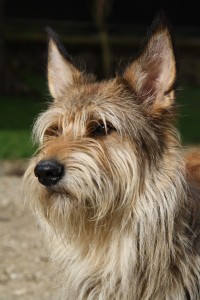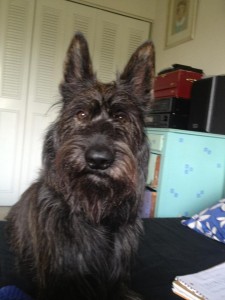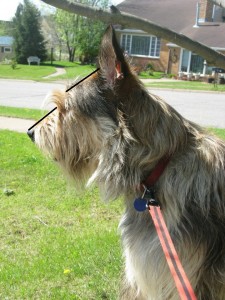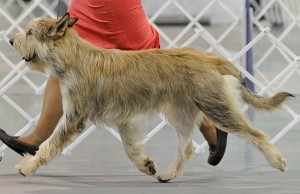Berger Picard Club of America Breed Standard
 I. General Appearance.
I. General Appearance.
The Berger Picard is an ancient breed developed by the farmers and sheep herders of the Picardy region of northern France. They are medium-sized, sturdily built & well-muscled without being bulky, slightly longer than tall, with distinctive erect natural ears, wiry coat of moderate length, and a tail reaching to the hock and ending in a J-hook. Movement is free and easy, efficient, and tireless to allow them to work all day on the farm and in the fields. They are lively and alert, observant, quietly confident, and can be aloof with strangers, but should not be timid or nervous. This is a rustic, working shepherd’s dog, without exaggeration or refinement.
 II. Size, Proportion, Substance.
II. Size, Proportion, Substance.
Size: Males, 23-½ to 25-½ inches, females 21-½ to 23-½ inches at the highest point of the withers. Up to 1” above or below limits shall be faulted.
DISQUALIFICATION: Males under22-1/2 or over 26-1/2 inches, and Females under 20-1/2 or over 24-1/2 inches.
Proportion: Measured from the point of shoulder to point of rump, the Picard should be slightly longer than the height at the highest point of the withers. Bitches may be slightly longer than dogs. Body length should be about 10% more than height. The distance from the withers to the elbow equals the distance from the elbow to the ground.
Substance: Bone should be sturdy and strong, and this framework is well-muscled without ever being bulky or ponderous. Must be sufficient to support work in the field all day, but not so massive as to interfere with free, efficient, light-footed movement.

III. Head
Head: Strong, without being massive; rectangular overall and narrowing slightly from ears to the eyes, and again from eyes to nose when viewed from above. The correct length of head, measured from occiput to nose, should be about the same length as the neck. Muzzle and top skull should be of equal length, and form parallel planes when viewed in profile, separated by a slight, sloping stop.
Expression: Alert and observant, spirited, confident, pleasant.
Eyes: Medium size, oval shaped and turned forward; neither round nor protruding. Eye color is medium to dark brown, but never lighter than hazel. Darker eye color is preferred. Eye rims are tight-fitting and fully pigmented.
DISQUALIFICATION: Yellow Eyes

Ears: Moderately large (4-5 inches long), broad at the base, tapering to a slightly rounded tip, and set rather high on the skull. Always carried naturally erect, and turned forward. Viewed from the front, carriage should be perpendicular or turned slightly out from perpendicular, at the 11 & 1 o’clock position. Coat on the ears should be short to moderate in length, not obscuring the shape of the ears. Ears tipped forward are to be severely faulted.
DISQUALIFICATION: Ears not carried erect or not standing.
Skull: Width is slightly less than the length, and very slightly rounded. Coat on the top of the skull is naturally shorter and gradually becomes longer at sides of skull and on cheeks, which makes the skull appear to be flat when viewed from the front. Cheek muscles are moderately strong and slightly rounded. There is a slight furrow between the bony arches over the eyes. The hair above the eyes falls forward, forming rough eyebrows that are not trimmed, nor are they so thick or long as to obscure the eyes.
Stop: Slight, gradual stop between the parallel planes of the muzzle and skull. Furrow between brow ridges blends smoothly into upper plane of muzzle.

Muzzle: Viewed from above, the muzzle tapers slightly from the stop to the nose, ending bluntly. It is powerful and never snipey. In profile, the bridge of the muzzle is straight, and parallel to the skull. Lips are thin and tight, with dark pigment. The hair on the muzzle forms a distinct moustache and beard, which is not overly long or bushy.
Planes: Viewed from the side, the muzzle and skull are in parallel planes.
Nose: Large, and always black.
Bite & Teeth: A complete set of evenly spaced, white teeth set in strong jaws, and meeting in a scissors bite. Three or more missing molars or premolars is a severe fault.
DISQUALIFICATION: Undershot or overshot bite with loss of contact between upper and lower incisors.
IV. Neck, Topline and Body

Neck: Strong and muscular, moderately long in length, blending smoothly into the shoulders and carried erect with a slight arch. Skin should fit cleanly without any dewlap.
Topline: Strong; level, from the withers, over a well-developed loin, to a slightly sloping croup.
Body: Chest deep but not exaggerated, reaching to the level of the elbow but not beyond. Prominent prosternum blends smoothly into the sternum. The lowest point of the sternum is at the level of the elbow, and from that point, the sternum slopes gradually up towards the loin to give good depth and length to the ribcage. Ribs are well sprung from the spine for the upper 1/3, then flattening as they approach the sternum, neither slab-sided nor barrel-shaped. Belly slightly tucked up. Loin strong but not overly long.
Tail: Strong at the base and tapering to the tip, flowing smoothly from the slightly sloping croup. At rest, hangs straight and reaches to the point of the hock, ending in a slight crook or “J” at the tip without deviating toward the right or left. When moving, carried as a natural extension of the topline. May be carried higher than the level of the topline, but never curled over the back. Coat is the same length and texture as the coat on the body. Tail curled over the back is a severe fault.
DISQUALIFICATION: Tail absent, docked, or kinked.
V. Forequarters
Shoulder blades are long and well laid back, covered by lean and strong muscle. The length of the upper arm balances the shoulder blade, placing the elbow well under and close in to the body. Forelegs are straight and strong, without being bulky. Viewed from the front, legs are parallel to each other with toes pointing straight forward. Pasterns slope slightly to a compact, rounded foot with well arched toes and strong, black nails. Pads are strong and supple. Dewclaws may be removed or left on.

VI. Hindquarters
Angulation of the thigh and stifle balance the front assembly, and are well muscled, providing powerful, tireless, and effortless movement. Rear pasterns are parallel to each other and perpendicular to the ground. With a correctly angulated rear, the toes of the hind foot land just behind a perpendicular line dropped from the point of rump. Feet are rounded with well arched toes and strong black nails, as in front. There should be no dewclaws on the rear legs.
VII. Coat.
Harsh and crisp to the touch, neither flat nor curly, often with a slight wave. Undercoat is soft, short, and dense. The shaggy, rough coat of the Picard is distinctive, and should never be wooly, soft, or so profuse that is hides the outline of the dog. Ideal length is 2-3” over the entire dog, with coat naturally somewhat shorter on the top of the head. The coat accents on the head and neck which give the Picard its distinct look, known as “griffonage”, include rough eyebrows, moderate beard and moustache, and a slight ruff on the front and sides of the neck, framing the head, all of moderate length. Coat length over 4” in any location should be penalized, with longer coats penalized more severely than those only slightly longer than ideal. Coat on the ears should never be so long as to obscure the outline, or create a fringed appearance. The Picard is shown in its rustic, rough, natural coat which is not to be sculpted, shaped, or scissored. Dogs whose coat has been altered by excessive grooming must be severely penalized.

VIII. Color.
Fawn or brindle. Fawn may be a clear or true fawn with no dark markings, or fawn charbonne’ (fawn with charcoal), which is fawn with dark trim on the outer edge of the ears and a grey underlay on the head and body. Grey underlay should not be so prominent that it “muddies” the overall fawn color. Brindle may be any shade of base color from almost black to light grey or fawn, with stripes or small patches of black, brown, red, grey, or fawn distributed throughout. All allowed colors should be considered equally. A small white patch on the chest or tips of toes is allowed, but not ideal. Toes entirely white or a white patch anywhere on the body must be faulted.
DISQUALIFICATION: Solid black or white, pied, spotted, or harlequin; entirely white foot or white “bib” on chest.
IX. Gait.
Movement is fluid and effortless, easily covering a lot of ground with each smooth stride. Strong, supple, agile movement is essential for a working shepherd's dog. Head carriage lowers to near the level of the topline when moving. Limbs move in a parallel planes when gaiting slowly, converging slightly forward towards the centerline with increased speed.
X. Temperament.
Lively and alert, observant, confident, even-tempered. May be aloof with strangers, but should not be timid or nervous. Aggressive or threatening behavior towards people or other dogs is a serious fault.
Faults & Disqualifications
Faults
Any departure from the foregoing description should be considered a fault. Those faults that would interfere with the dog's ability to function efficiently as a shepherd, guardian, and a farmer's helper should be considered more serious that deviations that are cosmetic or would not alter the ability to work.
Disqualifications
Males under 22-1/2 or over 26-1/2 inches, and Females under 20-1/2 or over 24-1/2 inches.
Yellow Eyes
Ears not carried erect or not standing.
Undershot or overshot bite with loss of contact between upper and lower incisors.
Tail absent, docked, or kinked.
Solid black or white, pied, spotted, or harlequin; entirely white foot or white “bib” on chest.
Approved December 13, 2011
For a printable pdf of this click here: BPCA-Standard-Review.pdf

